
15311826613
Click to add WeChatPrimary gold ores exposed to the air undergo weathering, gradually breaking into gold grains and rock debris. Under the transportation of external forces, the heavier particles accumulate on hillsides, riverbeds, and the shores of lakes and beaches. When these sediments have development value, they become placer gold ores. The beneficiation operation of placer gold ore can be divided into preparation operation and separation operation. Here, a brief introduction to the commonly used placer gold ore beneficiation equipment is provided.
The commonly used equipment for the gravity separation of placer gold ore mainly includes shaking tables, jigs, spiral chutes and spiral concentrators. During the separation process, the differences in particle size, shape and specific gravity among particles are utilized for separation and enrichment.
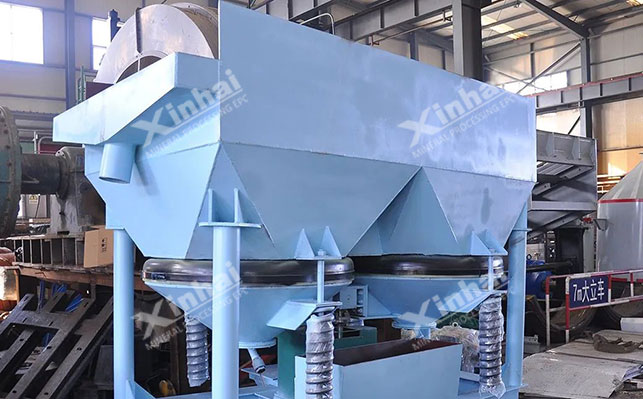
The jigging machine realizes mineral separation based on the principle of loose bed and stratification and is a commonly used equipment in placer gold ore beneficiation. During operation, the diaphragm is driven to move up and down reciprocately through the transmission mechanism, causing the water flow in the jigging chamber to pulsate periodically. During the process of water flow rising and falling, the ore particle groups stratify according to the density differences. The gold particles with higher density gradually settle to the bottom and are discharged through the ore discharge device to become heavy products. The low-density gangue minerals are located in the upper layer and are discharged with the water flow to become light products.
Jigging machines are suitable for processing coarse-grained (particle size ≥0.2mm) and medium-grained placer gold ores, and they perform well on ores with less clay content and relatively uniform particle size composition.
The jigging machine has a large processing capacity, with a single machine processing capacity of 50 to 500 tons per hour, making it suitable for large-scale industrial production. The recovery rate of coarse-grained gold is high, generally reaching over 90%.
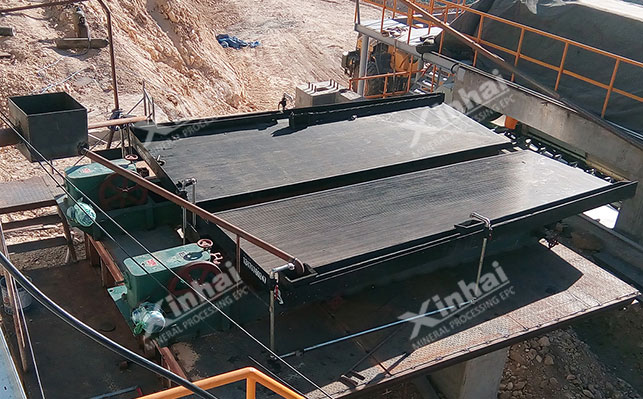
The bed surface of the shaker is trapezoidal or rhombic in shape. Driven by the transmission mechanism, it makes reciprocating differential motion, and at the same time, the water supply trough supplies lateral water flow to the bed surface. After the pulp is fed into the bed surface, under the combined effect of lateral water flow and bed surface vibration, the mineral particle groups are stratified and zoned according to differences in density, particle size and shape. Eventually, mineral particles of different properties are discharged in different areas of the bed surface.
The shaking table is particularly suitable for processing fine-grained and micro-fine-grained (particle size 0.074-2mm) placer gold ores, and it has a better separation effect on ores with low mud content and high gold particle monomer dissociation degree.
The shaking table has a high separation accuracy, which can accurately separate minerals and obtain high-grade gold concentrate, and is suitable for placer gold ores of different particle sizes and properties. The energy consumption is relatively low, and the operating cost of the equipment is relatively low.
The spiral chute achieves separation by taking advantage of the different movement trajectories of mineral particles due to density and particle size differences during the water flow movement in the spiral chute. The pulp is fed in from the top of the tank. Under the combined effect of gravity, centrifugal force and water flow force, the denser gold particles move to the outside of the tank and are discharged along the bottom of the tank, while the denser gangue minerals move to the inside and are discharged from the top.
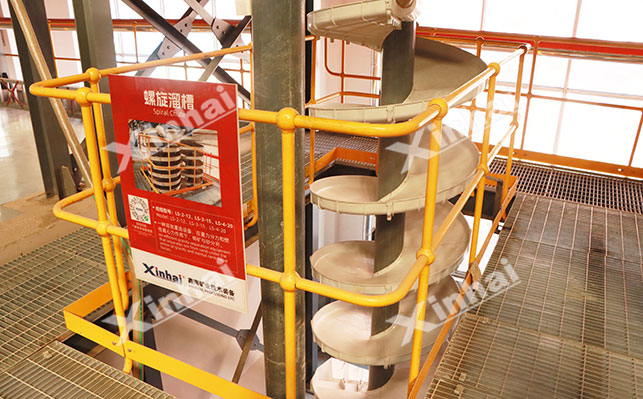
Spiral chutes are suitable for processing medium and fine-grained (particle size 0.04-2mm) placer gold ores, especially for processing ores with low mud content and uniform particle size.
The spiral chute produced by Xin Hai is made of high-quality wear-resistant engineering plastic, which can resist acids and alkalis, and is flame-retardant and cold-resistant. Compared with fiberglass reinforced plastic, it has a longer service life and a large processing capacity. The processing capacity of a single head is 1.5 to 2 tons per hour, and the processing capacity of a single unit can reach 6 tons per hour. It occupies a small area and is suitable for use in mountainous regions or areas with limited space.
The centrifugal concentrator mainly generates centrifugal force through high-speed rotation to enhance gravity separation. During the process, mineral particles are separated according to their densities. The denser gold particles quickly settle on the inner wall of the drum and are discharged through the discharge device. The low-density gangue minerals are discharged from the upper part of the drum along with the pulp.
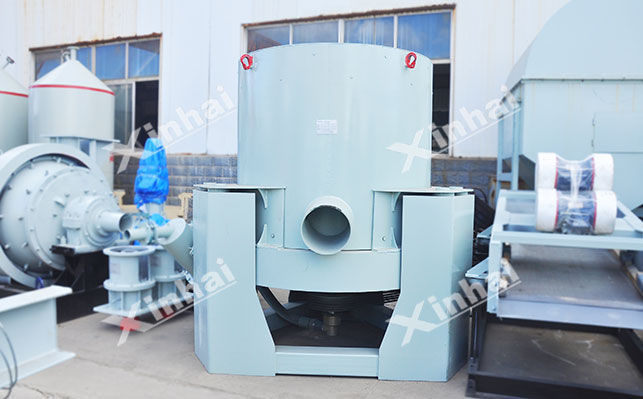
Centrifugal concentrators are more suitable for processing fine-grained (particle size ≤0.074mm) placer gold ores. They have a strong anti-interference ability for ores with high mud content and can effectively prevent fine gold from being wrapped in clay and lost.
The above are the commonly used gravity separation equipment for placer gold. However, during the beneficiation process, for some placer gold ores with larger particle sizes and good dissociability, if there are particles larger than 100mm in the mined placer gold ore, these coarse particles must be crushed before the separation operation to prevent the gold mixed inside from being lost to the tailings along with them during the separation process. The gold content in the fine-grained grade of placer gold is very low, and its recovery is difficult. However, the fine-grained grade of ore mud has a significant impact on the subsequent gravity separation operation, and pretreatment is required to remove the fine-grained ore mud.
The commonly used equipment for pretreatment operations before gravity separation of placer gold ores mainly includes cylindrical screens and vibrating screens.
The cylindrical ore washing screen operates through power transmission, allowing materials to be washed by the flushing water and rubbed against the cylinder wall inside the drum. Clayey and other muddy substances are dispersed and discharged with the water flow, while coarse-grained materials such as gravel are discharged through the screen holes, and fine-grained slurry flows out from the end of the cylinder.
The cylindrical ore washing screen is mostly suitable for processing placer gold ores with a high content of clay and gravel, especially clay-bonded placer gold ores. It has a high screening efficiency and can handle ores with a mud content as high as 30%. The single-machine processing capacity can reach 100-500 tons per hour.
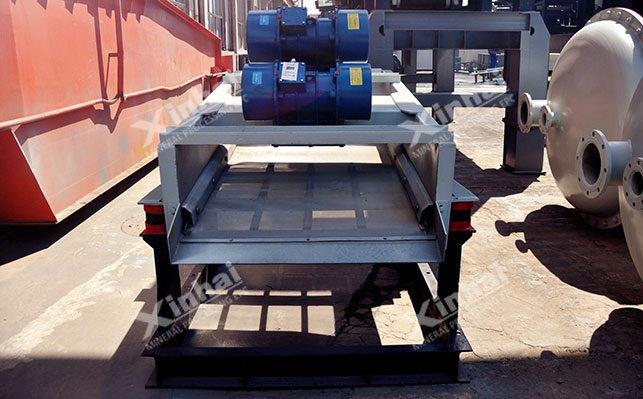
Vibrating screens achieve the screening and classification of mineral materials by causing the screen surface to vibrate through the excitation force generated by vibrating motors or eccentric blocks. During operation, the mineral materials are fed into the screen surface. Under the effect of vibration, particles smaller than the screen hole size pass through the screen mesh and become under-screen products, while particles larger than the screen hole size remain on the screen surface and become over-screen products.
Vibrating screens are mostly suitable for particle size classification of various placer gold ores, mainly used to remove coarse-grained gravel (particle size >20mm), providing appropriate feed particle size for subsequent gravity separation equipment.
The selection of placer gold ore beneficiation equipment needs to comprehensively consider multiple factors such as the nature of the ore, production scale, and investment cost. In practical applications, how to select equipment or how to combine the use of equipment to achieve the desired effect requires experimental analysis. Through beneficiation tests, the suitable type and model specifications of placer gold ore beneficiation equipment are provided.